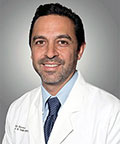- Home
- Foot & Ankle Conditions
- Pediatric Conditions
- Accessory Navicular
Accessory Navicular: causes, symptoms and treatment

What is an accessory navicular?
The accessory navicular (os tibiale externum) is an extra piece of cartilage or bone located midfoot just above the arch on the inside of the foot.
This ossicle (extra bone) is usually encased in the posterior tibial tendon, which attaches the foot's inside (medial) arch to the calf muscle. Accessory navicular is commonly seen in pediatric patients.
Most people do not have an accessory navicular. People who do have one are born with this condition and may go their whole lives without realizing it. Others will experience pain and foot deformities.
- Why does an accessory navicular require bone treatment?
- What are the symptoms of accessory navicular syndrome?
- How is accessory navicular syndrome diagnosed?
- What are accessory navicular treatment options?
- What is accessory navicular bone surgery?
- University Foot & Ankle Institute is ideal for accessory navicular treatment
-
Foot and Ankle Surgeon and Director of University Foot and Ankle Institute
Dr. Bob Baravaria DPM, FACFAS is a Board-Certified Podiatric Foot and Ankle Specialist. He is an assistant clinical professor at the UCLA School of Medicine and serves as Director of University Foot and Ankle Institute.
Dr. Baravarian has been involved in athletics his entire life and played competitive tennis in high school and college. He has an interest in sports medicine, arthritis therapy, and trauma/reconstructive surgery of the foot and ankle. He is also fluent in five languages (English, French, Spanish, Farsi, and Hebrew),
 Exceptional compassionate & skillful care by Dr Saeedi for two foot issues. The reception and X-ray tech were also wonderful, ...Robert B.
Exceptional compassionate & skillful care by Dr Saeedi for two foot issues. The reception and X-ray tech were also wonderful, ...Robert B. Overall, it was a great experience. I've been coming to Dr. Kellman for about a year and he and his staff are very helpful.Vanessa W.
Overall, it was a great experience. I've been coming to Dr. Kellman for about a year and he and his staff are very helpful.Vanessa W. ExcellentDebasish M.
ExcellentDebasish M. It was a positive experience.Kim H.
It was a positive experience.Kim H. Dr. Redkar treated my ingrown toenail expertly and sympathetically. I had a lot of questions, and she took the time to answer ...Susan M.
Dr. Redkar treated my ingrown toenail expertly and sympathetically. I had a lot of questions, and she took the time to answer ...Susan M. Everyone was friendly and professional.Victor L.
Everyone was friendly and professional.Victor L. Very efficient and an excellent serviceHorwitz J.
Very efficient and an excellent serviceHorwitz J. Chaos in the office checkin. We weren’t forewarned about the iPad data collection. That made me late for a following appointmen...Carl C.
Chaos in the office checkin. We weren’t forewarned about the iPad data collection. That made me late for a following appointmen...Carl C. Dr Nalbandian is an exceptional doctor and person. The staff respectfully & compently delt with an issue I had regarding a prev...Karen M.
Dr Nalbandian is an exceptional doctor and person. The staff respectfully & compently delt with an issue I had regarding a prev...Karen M. Visiting the office is a pleasurable occurance.Thomas J.
Visiting the office is a pleasurable occurance.Thomas J. Dr Kelman and his staff are always wonderfully caring and respectful to my father who has Alzheimer's dementia.Erland E.
Dr Kelman and his staff are always wonderfully caring and respectful to my father who has Alzheimer's dementia.Erland E. Thank you for being there for your patients.Dieter B.
Thank you for being there for your patients.Dieter B.
